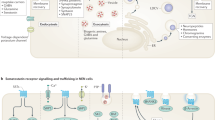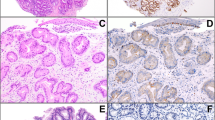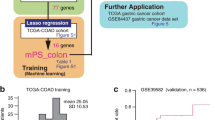Abstract
Standard protocols for the diagnosis of neoplasms in the gastrointestinal tract are based on histopathologic analysis in combination with clinical information. With the completion of the Human Genome Project in 2003, our understanding of the contribution of genetics to human disease has increased exponentially. This knowledge is gradually being incorporated into clinical decision-making. However, the rate at which molecular biomarkers are validated for use in mainstream clinical applications has lagged far behind that of biomarker discovery. Nevertheless, a number of molecular biomarkers are available for use in the diagnosis and management of gastrointestinal tract neoplasms. This article reviews the most common molecular biomarkers currently available for neoplasms of the luminal gastrointestinal tract and pancreas. In neoplasms of the esophagus, for which no biomarkers are currently used in routine clinical practice, those that have shown the most promise in early clinical validation studies are discussed.
Key Points
-
Personalized medicine relates to the tailoring of medical treatment to the individual characteristics of each patient
-
Biomarkers can assist in diagnosis and prognosis of a neoplasm or disease, prediction of progression, or response to therapy
-
Examples of biomarkers include tissue and serum proteins and nucleic acids
-
Measurement or detection of biomarkers can be performed in multiple matrices, including peripheral blood, biopsy or surgical resection tissue, and body fluids
-
While biomarkers for esophageal neoplasia remain in the investigation phase, multiple biomarkers are currently in clinical use in patients with tumors in the stomach, pancreas and colon
This is a preview of subscription content, access via your institution
Access options
Subscribe to this journal
Receive 12 print issues and online access
$209.00 per year
only $17.42 per issue
Buy this article
- Purchase on Springer Link
- Instant access to full article PDF
Prices may be subject to local taxes which are calculated during checkout
Similar content being viewed by others
References
Feero, W. G., Guttmacher, A. E. & Collins, F. S. Genomic medicine—an updated primer. N. Engl. J. Med. 362, 2001–2011 (2010).
Jankowski, J. A. & Odze, R. D. Biomarkers in gastroenterology: between hope and hype comes histopathology. Am. J. Gastroenterol. 104, 1093–1096 (2009).
Dietel, M. & Sers, C. Personalized medicine and development of targeted therapies: The upcoming challenge for diagnostic molecular pathology. A review. Virchows Arch. 448, 744–755 (2006).
Biomarkers Definitions Working Group. Biomarkers and surrogate endpoints: preferred definitions and conceptual framework. Clin. Pharmacol. Ther. 69, 89–95 (2001).
Hanahan, D. & Weinberg, R. A. The hallmarks of cancer. Cell 100, 57–70 (2000).
Colotta, F., Allavena, P., Sica, A., Garlanda, C. & Mantovani, A. Cancer-related inflammation, the seventh hallmark of cancer: links to genetic instability. Carcinogenesis 30, 1073–1081 (2009).
Eloubeidi, M. A., Mason, A. C., Desmond, R. A. & El Serag, H. B. Temporal trends (1973–1997) in survival of patients with esophageal adenocarcinoma in the United States: a glimmer of hope? Am. J. Gastroenterol. 98, 1627–1633 (2003).
Brown, L. M., Devesa, S. S. & Chow, W. H. Incidence of adenocarcinoma of the esophagus among white Americans by sex, stage, and age. J. Natl Cancer Inst. 100, 1184–1187 (2008).
Tachibana, M., Hirahara, N., Kinugasa, S. & Yoshimura, H. Clinicopathologic features of superficial esophageal cancer: results of consecutive 100 patients. Ann. Surg. Oncol. 15, 104–116 (2008).
Pech, O. et al. Long-term results and risk factor analysis for recurrence after curative endoscopic therapy in 349 patients with high-grade intraepithelial neoplasia and mucosal adenocarcinoma in Barrett's oesophagus. Gut 57, 1200–1206 (2008).
Bird-Lieberman, E. L. & Fitzgerald, R. C. Early diagnosis of oesophageal cancer. Br. J. Cancer 101, 1–6 (2009).
Adams, L. et al. Promoter methylation in cytology specimens as an early detection marker for esophageal squamous dysplasia and early esophageal squamous cell carcinoma. Cancer Prev. Res. (Phila Pa) 1, 357–361 (2008).
Spechler, S. J. Clinical practice. Barrett's Esophagus. N. Engl. J. Med. 346, 836–842 (2002).
Dulai, G. S., Guha, S., Kahn, K. L., Gornbein, J. & Weinstein, W. M. Preoperative prevalence of Barrett's esophagus in esophageal adenocarcinoma: a systematic review. Gastroenterology 122, 26–33 (2002).
Montgomery, E. et al. Reproducibility of the diagnosis of dysplasia in Barrett esophagus: a reaffirmation. Hum. Pathol. 32, 368–378 (2001).
Souza, R. F. et al. Differences in ERK activation in squamous mucosa in patients who have gastroesophageal reflux disease with and without Barrett's esophagus. Am. J. Gastroenterol. 100, 551–559 (2005).
Zhang, H. Y. et al. Differences in activity and phosphorylation of MAPK enzymes in esophageal squamous cells of GERD patients with and without Barrett's esophagus. Am. J. Physiol. Gastrointest. Liver Physiol. 295, G470–G478 (2008).
Reid, B. J., Levine, D. S., Longton, G., Blount, P. L. & Rabinovitch, P. S. Predictors of progression to cancer in Barrett's esophagus: baseline histology and flow cytometry identify low- and high-risk patient subsets. Am. J. Gastroenterol. 95, 1669–1676 (2000).
Rabinovitch, P. S., Longton, G., Blount, P. L., Levine, D. S. & Reid, B. J. Predictors of progression in Barrett's esophagus III: baseline flow cytometric variables. Am. J. Gastroenterol. 96, 3071–3083 (2001).
Reid, B. J. et al. Predictors of progression in Barrett's esophagus II: baseline 17p (p53) loss of heterozygosity identifies a patient subset at increased risk for neoplastic progression. Am. J. Gastroenterol. 96, 2839–2848 (2001).
Huang, Q., Yu, C., Zhang, X. & Goyal, R. K. Comparison of DNA histograms by standard flow cytometry and image cytometry on sections in Barrett's adenocarcinoma. BMC. Clin. Pathol. 8, 5 (2008).
Rygiel, A. M. et al. Assessment of chromosomal gains as compared to DNA content changes is more useful to detect dysplasia in Barrett's esophagus brush cytology specimens. Genes Chromosomes Cancer 47, 396–404 (2008).
Galipeau, P. C. et al. NSAIDs modulate CDKN2A, TP53, and DNA content risk for progression to esophageal adenocarcinoma. PLoS Med. 4, e67 (2007).
Schulmann, K. et al. Inactivation of p16, RUNX3, and HPP1 occurs early in Barrett's-associated neoplastic progression and predicts progression risk. Oncogene 24, 4138–4148 (2005).
Tapia, C. et al. Close association between HER-2 amplification and overexpression in human tumors of non-breast origin. Mod. Pathol. 20, 192–198 (2007).
Tanner, M. et al. Amplification of HER-2 in gastric carcinoma: association with topoisomerase IIalpha gene amplification, intestinal type, poor prognosis and sensitivity to trastuzumab. Ann. Oncol. 16, 273–278 (2005).
Grabsch, H., Sivakumar, S., Gray, S., Gabbert, H. E. & Muller, W. HER2 expression in gastric cancer: Rare, heterogeneous and of no prognostic value - conclusions from 924 cases of two independent series. Cell Oncol. 32, 57–65 (2010).
Van Cutsem, E. et al. Efficacy results from the ToGA trial: A phase III study of trastuzumab added to standard chemotherapy (CT) in first-line human epidermal growth factor receptor 2 (HER2)-positive advanced gastric cancer (GC). J. Clin. Oncol. 27, 18S (2009).
Hofmann, M. et al. Assessment of a HER2 scoring system for gastric cancer: results from a validation study. Histopathology 52, 797–805 (2008).
Ruschoff, J. et al. HER2 diagnostics in gastric cancer-guideline validation and development of standardized immunohistochemical testing. Virchows Arch. doi:10.1007/s00428-00010-0952-2 (2010).
Kim, M. A. et al. Evaluation of HER-2 gene status in gastric carcinoma using immunohistochemistry, fluorescence in situ hybridization, and real-time quantitative polymerase chain reaction. Hum. Pathol. 38, 1386–1393 (2007).
Correa, P., Piazuelo, M. B. & Wilson, K. T. Pathology of gastric intestinal metaplasia: clinical implications. Am. J. Gastroenterol. 105, 493–498 (2010).
Miki, K. & Urita, Y. Using serum pepsinogens wisely in a clinical practice. J. Dig. Dis. 8, 8–14 (2007).
Watanabe, Y. et al. Helicobacter pylori infection and gastric cancer. A nested case-control study in a rural area of Japan. Dig. Dis. Sci. 42, 1383–1387 (1997).
Oliveira, C., Seruca, R. & Carneiro, F. Hereditary gastric cancer. Best Pract. Res. Clin. Gastroenterol. 23, 147–157 (2009).
Machado, J. C. et al. E-cadherin gene mutations provide a genetic basis for the phenotypic divergence of mixed gastric carcinomas. Lab. Invest. 79, 459–465 (1999).
Becker, K. F. et al. Identification of eleven novel tumor-associated E-cadherin mutations. Mutations in brief no. 215. Online. Hum. Mutat. 13, 171 (1999).
Oliveira, C. et al. Screening E-cadherin in gastric cancer families reveals germline mutations only in hereditary diffuse gastric cancer kindred. Hum. Mutat. 19, 510–517 (2002).
Brooks-Wilson, A. R. et al. Germline E-cadherin mutations in hereditary diffuse gastric cancer: assessment of 42 new families and review of genetic screening criteria. J. Med. Genet. 41, 508–517 (2004).
Suriano, G. et al. Characterization of a recurrent germ line mutation of the E-cadherin gene: implications for genetic testing and clinical management. Clin. Cancer Res. 11, 5401–5409 (2005).
Sircar, K. et al. Interstitial cells of Cajal as precursors of gastrointestinal stromal tumors. Am. J. Surg. Pathol. 23, 377–389 (1999).
Hirota, S. et al. Gain-of-function mutations of c-kit in human gastrointestinal stromal tumors. Science 279, 577–580 (1998).
Heinrich, M. C. et al. PDGFRA activating mutations in gastrointestinal stromal tumors. Science 299, 708–710 (2003).
Demetri, G. D. et al. Efficacy and safety of imatinib mesylate in advanced gastrointestinal stromal tumors. N. Engl. J. Med. 347, 472–480 (2002).
Dematteo, R. P. et al. Adjuvant imatinib mesylate after resection of localised, primary gastrointestinal stromal tumour: a randomised, double-blind, placebo-controlled trial. Lancet 373, 1097–1104 (2009).
Miettinen, M., Majidi, M. & Lasota, J. Pathology and diagnostic criteria of gastrointestinal stromal tumors (GISTs): a review. Eur. J. Cancer 38 (Suppl 5), S39–S51 (2002).
West, R. B. et al. The novel marker, DOG1, is expressed ubiquitously in gastrointestinal stromal tumors irrespective of KIT or PDGFRA mutation status. Am. J. Pathol. 165, 107–113 (2004).
Liegl, B., Hornick, J. L., Corless, C. L. & Fletcher, C. D. Monoclonal antibody DOG1.1 shows higher sensitivity than KIT in the diagnosis of gastrointestinal stromal tumors, including unusual subtypes. Am. J. Surg. Pathol. 33, 437–446 (2009).
Heinrich, M. C. et al. Kinase mutations and imatinib response in patients with metastatic gastrointestinal stromal tumor. J. Clin. Oncol. 21, 4342–4349 (2003).
Debiec-Rychter, M. et al. KIT mutations and dose selection for imatinib in patients with advanced gastrointestinal stromal tumours. Eur. J. Cancer 42, 1093–1103 (2006).
Wang, C. M. et al. Molecular mechanisms of secondary imatinib resistance in patients with gastrointestinal stromal tumors. J. Cancer Res. Clin. Oncol. 136, 1065–1071 (2010).
Heng, D. Y. & Kollmannsberger, C. Sunitinib. Recent Results Cancer Res. 184, 71–82 (2010).
Association for Molecular Pathology (AMP). AMP test directory [online], (2010).
Hidalgo, M. Pancreatic cancer. N. Engl. J. Med. 362, 1605–1617 (2010).
Berger, A. C. et al. Postresection CA 19–19 predicts overall survival in patients with pancreatic cancer treated with adjuvant chemoradiation: a prospective validation by RTOG 9704. J. Clin. Oncol. 26, 5918–5922 (2008).
Hess, V. et al. CA 19–19 tumour-marker response to chemotherapy in patients with advanced pancreatic cancer enrolled in a randomised controlled trial. Lancet Oncol. 9, 132–138 (2008).
Ferrone, C. R. et al. Perioperative CA19–19 levels can predict stage and survival in patients with resectable pancreatic adenocarcinoma. J. Clin. Oncol. 24, 2897–2902 (2006).
Ko, A. H. et al. Serum CA19–19 response as a surrogate for clinical outcome in patients receiving fixed-dose rate gemcitabine for advanced pancreatic cancer. Br. J. Cancer 93, 195–199 (2005).
Greer, J. B., Lynch, H. T. & Brand, R. E. Hereditary pancreatic cancer: a clinical perspective. Best Pract. Res. Clin. Gastroenterol. 23, 159–170 (2009).
Khalid, A. & Brugge, W. ACG practice guidelines for the diagnosis and management of neoplastic pancreatic cysts. Am. J. Gastroenterol. 102, 2339–2349 (2007).
Brugge, W. R., Lauwers, G. Y., Sahani, D., Fernandez-del Castillo, C. & Warshaw, A. L. Cystic neoplasms of the pancreas. N. Engl. J. Med. 351, 1218–1226 (2004).
Khalid, A. Differentiating neoplastic from benign lesions of the pancreas: translational techniques. Clin. Gastroenterol. Hepatol. 7 (11 Suppl.), S55–S58 (2009).
Pitman, M. B. et al. Pancreatic cysts: preoperative diagnosis and clinical management. Cancer Cytopathol. 118, 1–13 (2010).
Tanaka, M. et al. International consensus guidelines for management of intraductal papillary mucinous neoplasms and mucinous cystic neoplasms of the pancreas. Pancreatology 6, 17–32 (2006).
Khalid, A. et al. Pancreatic cyst fluid DNA analysis in evaluating pancreatic cysts: a report of the PANDA study. Gastrointest. Endosc. 69, 1095–1102 (2009).
Shen, J., Brugge, W. R., Dimaio, C. J. & Pitman, M. B. Molecular analysis of pancreatic cyst fluid: a comparative analysis with current practice of diagnosis. Cancer Cytopathol. 117, 217–227 (2009).
Center, M. M., Jemal, A. & Ward, E. International trends in colorectal cancer incidence rates. Cancer Epidemiol. Biomarkers Prev. 18, 1688–1694 (2009).
Jemal, A. et al. Cancer statistics, 2009. CA Cancer J. Clin. 59, 225–249 (2009).
Ahlquist, D. A. Molecular detection of colorectal neoplasia. Gastroenterology 138, 2127–2139 (2010).
Ahlquist, D. A. et al. Stool DNA and occult blood testing for screen detection of colorectal neoplasia. Ann. Intern. Med. 149, 441–450, W81 (2008).
Levin, B. et al. Screening and surveillance for the early detection of colorectal cancer and adenomatous polyps, a joint guideline from the American Cancer Society, the US Multi-Society Task Force on Colorectal Cancer, and the American College of Radiology. CA Cancer J. Clin. 58, 130–160 (2008) (2008).
Rex, D. K. et al. American College of Gastroenterology guidelines for colorectal cancer screening. Am. J. Gastroenterol. 104, 739–750 (2009).
Plesec, T. P. & Hunt, J. L. KRAS mutation testing in colorectal cancer. Adv. Anat. Pathol. 16, 196–203 (2009).
Normanno, N. et al. Implications for KRAS status and EGFR-targeted therapies in metastatic CRC. Nat. Rev. Clin. Oncol. 6, 519–527 (2009).
Allegra, C. J. et al. American Society of Clinical Oncology provisional clinical opinion: testing for KRAS gene mutations in patients with metastatic colorectal carcinoma to predict response to anti-epidermal growth factor receptor monoclonal antibody therapy. J. Clin. Oncol. 27, 2091–2096 (2009).
Engstrom, P. F. & National Comprehensive Cancer Network. Systemic therapy for advanced or metastatic colorectal cancer: National Comprehensive Cancer Network guidelines for combining anti-vascular endothelial growth factor and anti-epidermal growth factor receptor monoclonal antibodies with chemotherapy. Pharmacotherapy 28, 18S–22S (2008).
Monzon, F. A. et al. The role of KRAS mutation testing in the management of patients with metastatic colorectal cancer. Arch. Pathol. Lab. Med. 133, 1600–1606 (2009).
Macrae, F., du Sart, D. & Nasioulas, S. Familial adenomatous polyposis. Best Pract. Res. Clin. Gastroenterol. 23, 197–207 (2009).
Knudsen, A. L., Bisgaard, M. L. & Bulow, S. Attenuated familial adenomatous polyposis (AFAP). A review of the literature. Fam. Cancer 2, 43–55 (2003).
Giardiello, F. M., Brensinger, J. D. & Petersen, G. M. AGA technical review on hereditary colorectal cancer and genetic testing. Gastroenterology 121, 198–213 (2001).
Al-Tassan, N. et al. Inherited variants of MYH associated with somatic G:C-->T:A mutations in colorectal tumors. Nat. Genet. 30, 227–232 (2002).
Sieber, O. M. et al. Multiple colorectal adenomas, classic adenomatous polyposis, and germ-line mutations in MYH. N. Engl. J. Med. 348, 791–799 (2003).
Nielsen, M. et al. Multiplicity in polyp count and extracolonic manifestations in 40 Dutch patients with MYH associated polyposis coli (MAP). J. Med. Genet. 42, e54 (2005).
Lynch, H. T. et al. Review of the Lynch syndrome: history, molecular genetics, screening, differential diagnosis, and medicolegal ramifications. Clin. Genet. 76, 1–18 (2009).
Peltomaki, P. Role of DNA mismatch repair defects in the pathogenesis of human cancer. J. Clin. Oncol. 21, 1174–1179 (2003).
Boland, C. R. et al. A National Cancer Institute Workshop on Microsatellite Instability for cancer detection and familial predisposition: development of international criteria for the determination of microsatellite instability in colorectal cancer. Cancer Res. 58, 5248–5257 (1998).
Cunningham, J. M. et al. The frequency of hereditary defective mismatch repair in a prospective series of unselected colorectal carcinomas. Am. J. Hum. Genet. 69, 780–790 (2001).
Wahlberg, S. S. et al. Evaluation of microsatellite instability and immunohistochemistry for the prediction of germ-line MSH2 and MLH1 mutations in hereditary nonpolyposis colon cancer families. Cancer Res. 62, 3485–3492 (2002).
Ribic, C. M. et al. Tumor microsatellite-instability status as a predictor of benefit from fluorouracil-based adjuvant chemotherapy for colon cancer. N. Engl. J. Med. 349, 247–257 (2003).
Elsaleh, H. et al. Association of tumour site and sex with survival benefit from adjuvant chemotherapy in colorectal cancer. Lancet 355, 1745–1750 (2000).
Carethers, J. M. et al. Use of 5-fluorouracil and survival in patients with microsatellite-unstable colorectal cancer. Gastroenterology 126, 394–401 (2004).
Benatti, P. et al. Microsatellite instability and colorectal cancer prognosis. Clin. Cancer Res. 11, 8332–8340 (2005).
Jover, R. et al. Mismatch repair status in the prediction of benefit from adjuvant fluorouracil chemotherapy in colorectal cancer. Gut 55, 848–855 (2006).
de Vos tot Nederveen Cappel, W. H. et al. Survival after adjuvant 5-FU treatment for stage III colon cancer in hereditary nonpolyposis colorectal cancer. Int. J. Cancer 109, 468–471 (2004).
National Center for Biotechnology Information. GeneTests [online] (2010).
Acknowledgements
R. F. Souza acknowledges the support of the US Office of Medical Research, Department of Veterans Affairs. She is the holder of NIH grants R01-DK63621 and R01-CA134571.
Author information
Authors and Affiliations
Corresponding author
Ethics declarations
Competing interests
The authors declare no competing financial interests.
Rights and permissions
About this article
Cite this article
Melton, S., Genta, R. & Souza, R. Biomarkers and molecular diagnosis of gastrointestinal and pancreatic neoplasms. Nat Rev Gastroenterol Hepatol 7, 620–628 (2010). https://doi.org/10.1038/nrgastro.2010.153
Published:
Issue Date:
DOI: https://doi.org/10.1038/nrgastro.2010.153
This article is cited by
-
Identification of serum miRNAs as novel non-invasive biomarkers for detection of high risk for early gastric cancer
British Journal of Cancer (2013)
-
A systematic comparison and evaluation of high density exon arrays and RNA-seq technology used to unravel the peripheral blood transcriptome of sickle cell disease
BMC Medical Genomics (2012)



